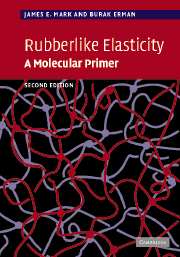Book contents
- Frontmatter
- Contents
- Preface to the first edition
- Preface to the second edition
- Part I Fundamentals
- Part II Additional topics
- 11 Networks prepared under unusual conditions
- 12 Strain-induced crystallization and ultimate properties
- 13 Multimodal networks
- 14 Birefringence and segmental orientation
- 15 Neutron scattering from networks
- 16 Liquid-crystalline elastomers
- 17 Bioelastomers
- 18 Filled elastomers
- 19 Current problems and new directions
- Appendix A Relationships between ν, ξ and Mc
- Appendix B Relationships between 〈r2〉, 〈(Δr)2〉, 〈r2〉0, and ϕ
- Appendix C Equations of state for miscellaneous deformations from the constrained junction theory
- Appendix D Thermodynamics of the relationship of stress to temperature
- Problems
- Answers to problems
- Some publications describing laboratory/classroom experiments or demonstrations
- References
- Index
11 - Networks prepared under unusual conditions
from Part II - Additional topics
Published online by Cambridge University Press: 04 December 2009
- Frontmatter
- Contents
- Preface to the first edition
- Preface to the second edition
- Part I Fundamentals
- Part II Additional topics
- 11 Networks prepared under unusual conditions
- 12 Strain-induced crystallization and ultimate properties
- 13 Multimodal networks
- 14 Birefringence and segmental orientation
- 15 Neutron scattering from networks
- 16 Liquid-crystalline elastomers
- 17 Bioelastomers
- 18 Filled elastomers
- 19 Current problems and new directions
- Appendix A Relationships between ν, ξ and Mc
- Appendix B Relationships between 〈r2〉, 〈(Δr)2〉, 〈r2〉0, and ϕ
- Appendix C Equations of state for miscellaneous deformations from the constrained junction theory
- Appendix D Thermodynamics of the relationship of stress to temperature
- Problems
- Answers to problems
- Some publications describing laboratory/classroom experiments or demonstrations
- References
- Index
Summary
Introduction
As can be gathered from Chapter 10, it is very difficult to obtain information on the topology of a network. Some studies have therefore taken an indirect approach. Networks were prepared in a way that could be expected to simplify their topologies, and their properties were measured and interpreted in terms of reduced degrees of network chain entangling.
The two techniques employed involved separating the chains prior to their cross linking by either dissolution (Johnson and Mark, 1972) or stretching (Greene et al., 1965). After the cross linking, the solvent is removed or the stretching force is relaxed, and the network is studied (unswollen) with regard to its stress–strain properties, typically in elongation.
Cross linking in solution
The preparation of networks by cross linking in solution followed by removal of the solvent (Erman and Mark, 1997) is shown schematically in Figure 11.1. Success in obtaining elastomers that had fewer entanglements was supported by the observation that such networks came to elastic equilibrium much more rapidly than elastomers cross linked in the dry state. Results of this type obtained on PDMS networks cross linked in solution by means of γ radiation are shown in Table 11.1 (Johnson and Mark, 1972, Mark et al., 1984). Note the continual decrease in the time required to reach elastic equilibrium, teq, and in the extent of stress relaxation as measured by the ratio of equilibrium to initial values of [f*], upon decrease in the volume fraction of polymer present during the cross linking.
Information
- Type
- Chapter
- Information
- Rubberlike ElasticityA Molecular Primer, pp. 111 - 116Publisher: Cambridge University PressPrint publication year: 2007
